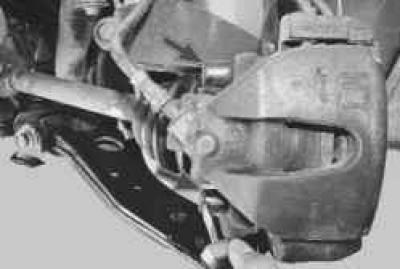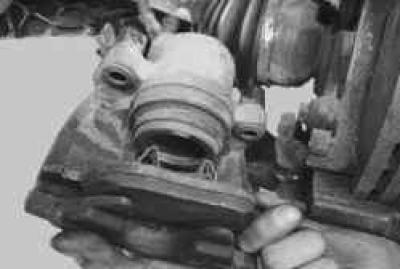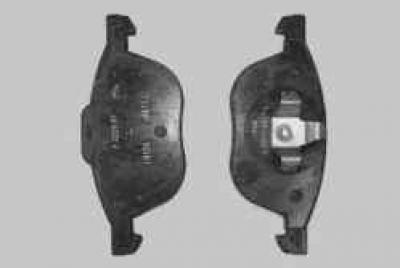Brake pads need to be replaced when the pads are worn (minimum allowable thickness of friction linings 1.5 mm), loose connection of linings with the base, oiling of working surfaces, the presence of deep grooves or chips.
WARNING: Replace the brake pads of the front brake mechanisms only in a set - 4 pcs. (two on each side).
WARNING: Before replacing the brake pads, check the brake fluid level in the master cylinder reservoir. If the level is close to the mark «MAX», it is necessary to pump out part of the liquid (for example, a medical syringe or a rubber bulb), because after replacing worn pads with new ones, the level will rise.
You will need: hex wrench «on 7», wrench for wheel nuts, large screwdriver.
1. Remove the left front wheel.

2. Inserting a large screwdriver between the inner brake shoe and the slave cylinder piston, press the piston into the cylinder.

3. Using pliers with thin jaws, remove the bent ends of the spring retainer of the outer pad from the holes in the caliper..

4.... and remove the retainer.

5. Prying off the covers of the protective bushings of both guide pins with a screwdriver..

6.... remove the covers.

7. Remove the bottom guide pin..

8.... and remove it from the hole in the guide shoe.
9. Similarly turn out and remove the second directing finger.

10. Remove the caliper together with the inner brake shoe from the shoe guide, making sure that the brake hose is not stretched or twisted..

11.... and remove the inner brake shoe by removing its spring retainer from the piston cavity.

12. Remove the outer block, removing it from the grooves of the guide.
NOTE: Note

NOTE: Pay attention to the markings on the brake pads. Buy new pads with the same markings.
13. Examine a spring clamp of an external block. Replace severely deformed or corroded retainer.
USEFUL ADVICE: Every time you replace the brake pads, be sure to check the condition of the protective plastic bushings of the guide pins and the movement of the caliper relative to the brake pad guide. If movement is difficult, lubricate the caliper guide pins with grease.
HINT: If the guide pin guards are damaged or their covers do not lock into the bushing holes, replace the guards.
14. Install the front brake pads in the reverse order of removal. To prevent self-loosening of the caliper guide pins, lubricate their threads before installing with an anaerobic thread locker.
15. Press the brake pedal several times to bring the brake pads to the disc.
16. Install the wheel.
17. Similarly replace the brake shoes of the brake mechanism of the right wheel.
18. Check up and if necessary restore level of a brake liquid in a tank of the main brake cylinder.
USEFUL ADVICE: After replacing worn out brake pads with new ones, do not rush to immediately go to busy highways. It is possible that at the very first intensive braking you will be unpleasantly surprised by the low efficiency of the brakes, although the pads were branded. Brake discs also wear out, and new pads only touch them at the edges, with little to no braking. Choose a quiet street or passage without cars and slow down gently several times so that the pads get used and begin to fit the entire surface. At the same time evaluate the effectiveness of the brakes.
USEFUL ADVICE: Try not to brake sharply for at least the first 100 km. With strong heating of unprocessed pads, the top layer of their pads burns and the brakes will not be as effective as possible for a long time.
Visitor comments